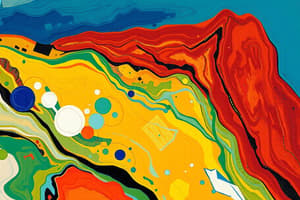Podcast
Questions and Answers
Which geological discipline primarily focuses on determining the age and correlation of rock layers in different locations?
Which geological discipline primarily focuses on determining the age and correlation of rock layers in different locations?
- Hydrogeology
- Economic geology
- Stratigraphy (correct)
- Paleontology
A construction project is planned for an area with complex soil conditions. Which subdiscipline would be most suitable to assess the soil's properties and behavior under load?
A construction project is planned for an area with complex soil conditions. Which subdiscipline would be most suitable to assess the soil's properties and behavior under load?
- Hydrogeology
- Rock mechanics
- Soil mechanics (correct)
- Economic geology
In the context of historical geology, what is the primary goal?
In the context of historical geology, what is the primary goal?
- To study the distribution and movement of groundwater resources.
- To locate and extract mineral deposits for economic gain.
- To analyze the chemical composition of rocks to determine their origin.
- To reconstruct the geological history of Earth using various geological principles and methods. (correct)
Which field combines principles from geology, soil mechanics, rock mechanics, and structural engineering to design foundations for large structures?
Which field combines principles from geology, soil mechanics, rock mechanics, and structural engineering to design foundations for large structures?
What is the focus of economic geology?
What is the focus of economic geology?
How does hydrogeology contribute to environmental management and sustainability?
How does hydrogeology contribute to environmental management and sustainability?
A paleontologist discovers microscopic fossils in a rock sample. What type of geological study does this exemplify?
A paleontologist discovers microscopic fossils in a rock sample. What type of geological study does this exemplify?
Which of the following scenarios would most directly involve the expertise of an engineering geologist?
Which of the following scenarios would most directly involve the expertise of an engineering geologist?
Which concept, championed by Georges Cuvier, posits that new life-forms migrated following localized catastrophic events?
Which concept, championed by Georges Cuvier, posits that new life-forms migrated following localized catastrophic events?
A geologist observes a distinct surface dividing a granite intrusion and overlying sandstone. Which term accurately describes this geological feature?
A geologist observes a distinct surface dividing a granite intrusion and overlying sandstone. Which term accurately describes this geological feature?
Which principle, articulated by Nicolaus Steno, suggests layers of sedimentary rock were originally deposited horizontally?
Which principle, articulated by Nicolaus Steno, suggests layers of sedimentary rock were originally deposited horizontally?
In a sequence of undisturbed sedimentary strata, which principle allows geologists to determine the relative ages of the rock layers?
In a sequence of undisturbed sedimentary strata, which principle allows geologists to determine the relative ages of the rock layers?
A geologist finds matching sedimentary strata on opposite sides of a wide canyon. Which principle helps correlate these formations?
A geologist finds matching sedimentary strata on opposite sides of a wide canyon. Which principle helps correlate these formations?
What geological event is theorized to have occurred approximately 4.5 billion years ago, resulting in the formation of the Moon?
What geological event is theorized to have occurred approximately 4.5 billion years ago, resulting in the formation of the Moon?
Which term describes a body of rock with a distinctive structure bounded bycontacts, useful for mapping and understanding regional geology?
Which term describes a body of rock with a distinctive structure bounded bycontacts, useful for mapping and understanding regional geology?
What does the study of stratigraphy primarily focus on?
What does the study of stratigraphy primarily focus on?
Which scenario most accurately exemplifies Steno's Law of Cross-Cutting Relationships?
Which scenario most accurately exemplifies Steno's Law of Cross-Cutting Relationships?
Which of the following geological features provides the strongest evidence of a significant hiatus (gap) in the geologic record, involving substantial erosion over an extended period?
Which of the following geological features provides the strongest evidence of a significant hiatus (gap) in the geologic record, involving substantial erosion over an extended period?
How could a geologist differentiate between a disconformity and a paraconformity in the field, assuming no radiometric dating is available?
How could a geologist differentiate between a disconformity and a paraconformity in the field, assuming no radiometric dating is available?
During which geologic era did the most significant diversification and proliferation of marine invertebrates occur, marking a pivotal shift in Earth's biodiversity?
During which geologic era did the most significant diversification and proliferation of marine invertebrates occur, marking a pivotal shift in Earth's biodiversity?
If a newly discovered rock stratum contains fossils of both early dinosaurs and primitive mammals, to which geologic era and period would this stratum most likely belong?
If a newly discovered rock stratum contains fossils of both early dinosaurs and primitive mammals, to which geologic era and period would this stratum most likely belong?
Which factor most significantly differentiates the focus of petrology from that of mineralogy?
Which factor most significantly differentiates the focus of petrology from that of mineralogy?
Why is the study of structural geology crucial in assessing the risk of earthquakes in seismically active regions?
Why is the study of structural geology crucial in assessing the risk of earthquakes in seismically active regions?
How does crystallography contribute to the field of material science beyond the study of minerals?
How does crystallography contribute to the field of material science beyond the study of minerals?
What is the essential difference in composition between rocks and soils, relevant to their geological classification?
What is the essential difference in composition between rocks and soils, relevant to their geological classification?
What is the primary reason for studying physical geology in the context of urban planning and civil engineering?
What is the primary reason for studying physical geology in the context of urban planning and civil engineering?
In what fundamental way does a crystal differ from a mineral, considering their atomic structure and origin?
In what fundamental way does a crystal differ from a mineral, considering their atomic structure and origin?
How might a geologist apply principles from both mineralogy and petrology to assess the environmental impact of acid mine drainage?
How might a geologist apply principles from both mineralogy and petrology to assess the environmental impact of acid mine drainage?
Which scenario exemplifies how structural geology directly informs decisions related to resource extraction and management?
Which scenario exemplifies how structural geology directly informs decisions related to resource extraction and management?
Which of the following scenarios best exemplifies the application of the principle of 'uniformity of kind' in historical geology?
Which of the following scenarios best exemplifies the application of the principle of 'uniformity of kind' in historical geology?
In the context of radioactive dating, how does the concept of 'half-life' directly influence the accuracy and applicability of this method for determining the absolute age of geological samples?
In the context of radioactive dating, how does the concept of 'half-life' directly influence the accuracy and applicability of this method for determining the absolute age of geological samples?
How would the discovery of a previously unknown, highly accelerated radioactive decay process challenge the fundamental assumptions underlying absolute dating methods in historical geology?
How would the discovery of a previously unknown, highly accelerated radioactive decay process challenge the fundamental assumptions underlying absolute dating methods in historical geology?
Imagine a geological formation shows evidence of both gradual sedimentary deposition and a sudden, large-scale volcanic eruption. How would a geologist reconcile these observations using the principles of uniformitarianism and catastrophism?
Imagine a geological formation shows evidence of both gradual sedimentary deposition and a sudden, large-scale volcanic eruption. How would a geologist reconcile these observations using the principles of uniformitarianism and catastrophism?
Which of the following statements accurately distinguishes between relative and absolute dating methods in geology, particularly concerning their reliance on numerical age assignments?
Which of the following statements accurately distinguishes between relative and absolute dating methods in geology, particularly concerning their reliance on numerical age assignments?
How does the 'theory of catastrophism' explain geological changes, and what is its main contrast to the 'theory of uniformitarianism'?
How does the 'theory of catastrophism' explain geological changes, and what is its main contrast to the 'theory of uniformitarianism'?
How might the discovery of a new geological process that operates outside the principles of uniformitarianism affect our understanding of Earth's history?
How might the discovery of a new geological process that operates outside the principles of uniformitarianism affect our understanding of Earth's history?
A geologist discovers a previously unknown radioactive isotope with an extremely short half-life. What implications would this discovery have for radioactive dating techniques?
A geologist discovers a previously unknown radioactive isotope with an extremely short half-life. What implications would this discovery have for radioactive dating techniques?
Flashcards
Geology
Geology
The scientific study of the Earth's structure, composition, and processes.
Physical Geology
Physical Geology
Deals with the Earth's structure, composition, and physical features.
Crystallography
Crystallography
Studies the arrangement of atoms in crystalline solids.
Mineralogy
Mineralogy
Signup and view all the flashcards
Minerals
Minerals
Signup and view all the flashcards
Crystals
Crystals
Signup and view all the flashcards
Petrology
Petrology
Signup and view all the flashcards
Rocks
Rocks
Signup and view all the flashcards
Stratigraphy
Stratigraphy
Signup and view all the flashcards
Paleontology
Paleontology
Signup and view all the flashcards
Historical Geology
Historical Geology
Signup and view all the flashcards
Economic Geology
Economic Geology
Signup and view all the flashcards
Hydrogeology
Hydrogeology
Signup and view all the flashcards
Engineering Geology
Engineering Geology
Signup and view all the flashcards
Geotechnical Engineering
Geotechnical Engineering
Signup and view all the flashcards
Rock Mechanics
Rock Mechanics
Signup and view all the flashcards
Cross-Cutting Relationships
Cross-Cutting Relationships
Signup and view all the flashcards
Unconformity in Geology
Unconformity in Geology
Signup and view all the flashcards
Angular Unconformity
Angular Unconformity
Signup and view all the flashcards
Disconformity
Disconformity
Signup and view all the flashcards
Nonconformity
Nonconformity
Signup and view all the flashcards
Relative Age
Relative Age
Signup and view all the flashcards
Absolute Age
Absolute Age
Signup and view all the flashcards
Radioactive Dating
Radioactive Dating
Signup and view all the flashcards
Half-life
Half-life
Signup and view all the flashcards
Uniformitarianism
Uniformitarianism
Signup and view all the flashcards
Uniformity of Law
Uniformity of Law
Signup and view all the flashcards
Catastrophism
Catastrophism
Signup and view all the flashcards
Catastrophism Theory
Catastrophism Theory
Signup and view all the flashcards
Giant Impact Hypothesis
Giant Impact Hypothesis
Signup and view all the flashcards
Contact (Geology)
Contact (Geology)
Signup and view all the flashcards
Stratum
Stratum
Signup and view all the flashcards
Strata
Strata
Signup and view all the flashcards
Formation (Geology)
Formation (Geology)
Signup and view all the flashcards
Outcrop/Exposure
Outcrop/Exposure
Signup and view all the flashcards
Study Notes
- Geology is the scientific study of Earth's structure, composition, and the processes shaping its surface.
- Geologists study rocks, minerals, and Earth's interior, reconstruct Earth's history, assess natural hazards, and provide insights for resource exploration and environmental management.
Branches of Geology
- Physical Geology focuses on Earth's structure, composition, physical properties, rocks, minerals, and surface features.
- Crystallography studies the arrangement and bonding of atoms in crystalline solids and the geometric structure of crystal lattices.
- Mineralogy examines all aspects of minerals, including physical properties, chemical composition, internal crystal structure, occurrence, distribution, and formation conditions.
- Petrology is the study of rocks (igneous, metamorphic, and sedimentary) and the processes that form and transform them.
- Structural Geology studies the form, arrangement, and internal structure of rocks, especially on a moderate to small scale.
- Stratigraphy describes rock successions and their interpretation in terms of a general time scale.
- Paleontology studies the life of the geologic past through the analysis of plant and animal fossils, including microscopic ones.
- Historical Geology reconstructs the geological history of Earth.
- Economic Geology studies the distribution of mineral deposits, economic factors in their recovery, and assessment of reserves.
- Hydrogeology studies the occurrence, distribution, and movement of water beneath Earth's surface.
- Engineering Geology applies geologic information to construction sites for foundation design and support.
Crystals vs Minerals
- Minerals are naturally occurring, inorganic substances with a definite chemical composition and crystalline structure.
- Crystals are solids with a regular, repeating arrangement of atoms, molecules, or ions, forming from minerals or other substances like organic or synthetic materials.
Rocks vs Soils
- Rocks are aggregates of minerals found in the Earth's crust, consisting of one or more minerals.
- Soils are unconsolidated materials from the disintegration of different rock types, composed of a mixture of minerals, organic matter, gases, liquids, and organisms.
Geotechnical Engineering
- Geotechnical engineering studies the engineering behavior of earth materials, using principles of soil and rock mechanics, geology, geophysics, and hydrology.
- Foundation engineering applies geology, soil mechanics, rock mechanics, and structural engineering to design and construct foundations for civil engineering structures.
- Rock mechanics studies the fundamental principles governing the behavior of all rock and rock masses.
- Soil mechanics studies the fundamental principles governing the behavior of all soil and soil masses.
Historical Geology
- Historical Geology studies changes to Earth and life in time and space.
Types of Ages
- Relative time (relative age) measures time using comparison methods.
- Absolute time (absolute age) measures time using actual numbers.
Measuring Earth's Age
- Earth's relative age is measured using rock layers and faults.
- Earth's absolute age is measured using radioactive dating.
Radioactive Dating
- Radioactive dating involves the breakdown of atoms to form different isotopes.
- Carbon-14 decays to Carbon-12.
- Energy is given off in the form of gamma rays, alpha particles, and beta particles.
Common Radioactive Dating Techniques
- Uranium-lead dating (U-235 to Pb-207)
- Samarium-neodymium dating (Sm-147 to Nd-143)
- Potassium-argon dating (K-40 to Ar-40)
- Rubidium-strontium dating (Rb-87 to Sr-87)
- Uranium-thorium dating (U-234 to Th-230)
- Radioactive carbon dating (C-14 proportions)
Half-Life
- Half-life is the time it takes for half of the original atoms to decay.
- Uranium-238 has a half-life of 4.5 billion years.
- Carbon-14 has a half-life of 5,700 years.
- Oxygen has a half-life of 19 seconds.
Fundamental Theories of Historical Geology
- Two theories are Uniformitarianism and Catastrophism.
Theory of Uniformitarianism
- Uniformitarianism suggests that the landscape developed over long periods through slow geologic processes, proposed by James Hutton in 1785 and expanded by Charles Lyell in the 1830s.
- "The present is the key to the past."
Lyell's Uniformitarianism Propositions
- Uniformity of law: natural laws are constant across time and space.
- Uniformity of methodology: use present-day analogies to explain the geological past.
- Uniformity of kind: past and present causes are the same and produce the same effects.
- Uniformity of degree: geological circumstances have remained the same over time.
Theory of Catastrophism
- Catastrophism is the idea that the earth has been affected by sudden, short-lived, violent events.
- First popularized by Georges Cuvier in the 19th century.
Impact Hypothesis
- Giant impact hypothesis: A large planetesimal impacted the early earth, blowing out rocky debris, which remelted and formed the moon.
Fundamental Principles of Historical Geology
- Contact: distinct surface between two unlike bodies of rocks
- Stratum: single layer/bed of rock
- Strata: multiple layers/beds of rocks
- Stratigraphy: study of strata
- Formation: a body of rock with distinctive structure that is bounded by contacts
- Outcrop/Exposure: locations where rocks are exposed at the earth's surface
Steno's Laws of Historical Geology
- Nicolaus Steno formulated these in 1669.
Steno's Law of Superposition
- In an undeformed sequence of sedimentary rocks, each bed is younger than the one below it and older than the one above it.
Steno's Law of Original Horizontality
- Sedimentary rocks are horizontal because original sediments were horizontal.
- Steeply inclined strata have been moved from their original position.
- Strata that are either perpendicular to the horizon or inclined to it, were at one time parallel to the horizon.
Steno's Law of Lateral Continuity
- Strata originally extended in all directions until they thinned to zero at their edges of deposition.
Unconformity Definition
- Unconformities are gaps in the geologic record, indicating episodes of crustal deformation, erosion, and sea-level variations.
- Unconformities represent times when deposition stopped, erosion occurred, and deposition resumed.
Types of Unconformities
- Angular Unconformities: older sediments are tilted, truncated by erosion, and then a younger package of sediments are deposited on this erosion surface.
- Disconformities: erosion surface between two packages of sediment, but the lower package of sediments was not tilted prior to deposition.
- Nonconformities: unconformities that separate igneous or metamorphic rocks from overlying sedimentary rocks, indicating a long period of erosion.
Summarized Geologic Time Scale
- Paleozoic Era: Age of invertebrates
- Cambrian Period
- Ordovician Period
- Silurian Period
- Devonian Period
- Carboniferous Period
- Permian Period
- Mesozoic Era: Age of dinosaurs and reptiles
- Triassic Period
- Jurassic Period
- Cretaceous Period
- Cenozoic Era: Age of mammals
- Tertiary Period
- Quaternary Period
Studying That Suits You
Use AI to generate personalized quizzes and flashcards to suit your learning preferences.



